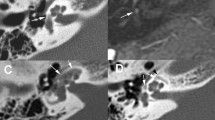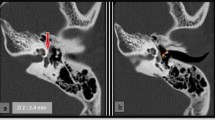Abstract
Objective
To assess the diagnostic efficacy and therapeutic impact of CT in evaluating patients with clinically suspected otosclerosis.
Methods
CT scans performed over a 5-year period for clinically suspected otosclerosis were retrospectively reviewed. CT diagnoses were correlated with subsequent surgical management. For otosclerosis positive cases, clinically significant extensions of otosclerosis were correlated with audiometry and the diagnosis was correlated with surgical findings.
Results
Of 259 CT studies, 46 % of patients were positive, 49 % negative and 5 % equivocal for otosclerosis. A relevant alternative CT diagnosis was evident in 33 % of the negative studies. One targeted surgery was performed for every four CT studies. CT outcome influenced the decision to perform stapedectomy in 41 % CT-positive versus 4 % CT-negative patients. CT-positive ears for otosclerosis could not be predicted from baseline clinical or audiometric criteria. Those with endosteal extension demonstrated lower bone conduction thresholds presurgically. The positive predictive value of CT diagnosis of otosclerosis was 100 %.
Conclusions
CT demonstrated a high rate of clinically relevant diagnoses in both CT-positive and -negative for otosclerosis patients, and this frequently influenced surgical management. CT also added value by demonstrating relevant extensions of the otosclerotic foci, some of which were predictive of audiometric parameters.
Key Points
• CT demonstrates a high rate of alternative diagnoses in suspected otosclerosis, 1:3.
• CT results in a high rate of targeted surgery in suspected otosclerosis, 1:4.
• CT prevents exploratory surgery in suspected otosclerosis.
• Endosteal extension of otosclerosis is predictive of lower bone conduction tresholds presurgically.
• The PPV of CT diagnosis of otosclerosis was 100 %.



Similar content being viewed by others
Abbreviations
- ABG:
-
Air bone gap
- AC:
-
Air conduction
- BC:
-
Bone conduction
- SNHL:
-
Sensorineural hearing loss
References
Linthicum FH Jr (1993) Histopathology of otosclerosis. Otolaryngol Clin North Am 26:335–52
Naumann IC, Porcellini B, Fisch U (2005) Otosclerosis: incidence of positive findings on high-resolution computed tomography and their correlation to audiological test data. Ann Otol Rhinol Laryngol 114:709–16
Lagleyre S, Sorrentino T, Calmels MN et al (2009) Reliability of high-resolution CT scan in diagnosis of otosclerosis. Otol Neurotol 30:1152–9
Marx M, Lagleyre S, Escude B et al (2011) Correlations between CT scan findings and hearing thresholds in otosclerosis. Acta Otolaryngol 131:351–7
Morrison A (1970) Otosclerosis: A Synopsis of Natural History and Management. BMJ 2:345–348
Shin YJ, Fraysse B, Deguine O, Cognard C, Charlet JP, Sevely A (2001) Sensorineural hearing loss and otosclerosis: a clinical and radiologic survey of 437 cases. Acta Otolaryngol 121:200–4
Fryback DG, Thornbury JR (1991) The efficacy of diagnostic imaging. Med Decis Making 11:88–94
Wycherly BJ, Berkowitz F, Noone AM, Kim HJ (2010) Computed tomography and otosclerosis: a practical method to correlate the sites affected to hearing loss. Ann Otol Rhinol Laryngol 119:789–94
Mansour S, Nicolas K, Ahmad HH (2011) Round window otosclerosis: radiologic classification and clinical correlations. Otol Neurotol 32:384–92
Purohit B, Hermans R, Op de Beeck K (2014) Imaging in otosclerosis: A pictorial review. Insights Imaging 5:245–52
Grayeli AB, Yrieix CS, Imauchi Y, Cyna-Gorse F, Ferrary E, Sterkers O (2004) Temporal bone density measurements using CT in otosclerosis. Acta Otolaryngol 124:1136–40
Kiyomizu K, Tono T, Yang D, Haruta A, Kodama T, Komune S (2004) Correlation of CT analysis and audiometry in Japanese otosclerosis. Auris Nasus Larynx 31:125–9
Rotteveel LJ, Proops DW, Ramsden RT, Saeed SR, van Olphen AF, Mylanus EA (2004) Cochlear implantation in 53 patients with otosclerosis: demographics, computed tomographic scanning, surgery, and complications. Otol Neurotol 25:943–52
Marshall AH, Fanning N, Symons S, Shipp D, Chen JM, Nedzelski JM (2005) Cochlear implantation in cochlear otosclerosis. Laryngoscope 115:1728–33
Veillon F, Stierle JL, Dussaix J, Ramos-Taboada L, Riehm S (2006) Imagerie de l’otospongiose : confrontation clinique et imagerie. J Radiol 87:1756–64
Lee TC, Aviv RI, Chen JM, Nedzelski JM, Fox AJ, Symons SP (2009) CT grading of otosclerosis. AJNR Am J Neuroradiol 30:1435–9
Causse JR, Causse JB, Bretlau P et al (1989) Etiology of otospongiotic sensorineural losses. Am J Otol 10:99–107
Rüedi L (1969) Otosclerotic lesion and cochlear degeneration. Arch Otolaryngol 89:364–71
Virk JS, Singh A, Kumar Lingam RK (2013) The Role of Imaging in the Diagnosis and Management of Otosclerosis. Otol Neur 34:e55–60
Thiers FA, Valvassori GE, Nadol JB Jr (1999) Pathology case of the month: otosclerosis of the cochlear capsule: correlation of computerized tomography and histopathology. Am J Otol 20:93–5
Karosi T, Csomor P, Sziklai I (2012) The value of HRCT in stapes fixations corresponding to hearing thresholds and histologic findings. Otol Neurotol 33:1300–7
Acknowledgments
The scientific guarantor of this publication is Dr. Steve Connor. The authors of this manuscript declare no relationships with any companies, whose products or services may be related to the subject matter of the article.
The authors state that this work has not received any funding. No complex statistical methods were necessary for this paper. Institutional Review Board approval was obtained. Written informed consent was waived by the Institutional Review Board. Methodology: retrospective, diagnostic or prognostic study, performed at one institution.
Author information
Authors and Affiliations
Corresponding author
Rights and permissions
About this article
Cite this article
Dudau, C., Salim, F., Jiang, D. et al. Diagnostic efficacy and therapeutic impact of computed tomography in the evaluation of clinically suspected otosclerosis. Eur Radiol 27, 1195–1201 (2017). https://doi.org/10.1007/s00330-016-4446-8
Received:
Accepted:
Published:
Issue Date:
DOI: https://doi.org/10.1007/s00330-016-4446-8




